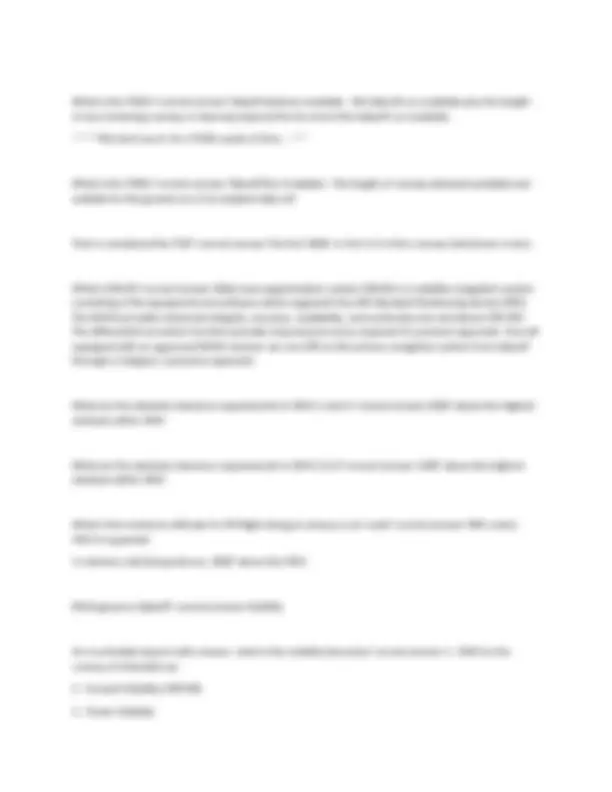






Study with the several resources on Docsity

Earn points by helping other students or get them with a premium plan


Prepare for your exams
Study with the several resources on Docsity

Earn points to download
Earn points by helping other students or get them with a premium plan
Community
Ask the community for help and clear up your study doubts
Discover the best universities in your country according to Docsity users
Free resources
Download our free guides on studying techniques, anxiety management strategies, and thesis advice from Docsity tutors
A comprehensive q&a format covering essential aspects of aviation, specifically focusing on ifr procedures. it delves into crucial concepts such as decision altitude (da), minimum descent altitude (mda), runway visual range (rvr), and various approach minima. The questions and answers are detailed and cover a wide range of topics, making it a valuable resource for pilots and aviation students. Particularly useful for understanding the complexities of approach and landing procedures under ifr conditions, including obstacle clearance requirements and alternate airport planning. it also clarifies the use of different types of visibility information and how they impact flight operations. This resource is ideal for those seeking a thorough understanding of ifr flight procedures and their practical application.
Typology: Exams
1 / 8

This page cannot be seen from the preview
Don't miss anything!





How often is the CAP GEN updated? correct answer Every 56 days What is ASDA? correct answer Accelerate Stop Distance Available - includes runway and stop way What does BPOC mean? correct answer Before Proceeding on Course - must complete the procedure before taking action to intercept your desired course What is a clearway? correct answer Rectangular area at the end of a runway, clear of obstacles, over which the initial climb-out can be made to a specified height (TODA-TORA) When are contour lines depicted on plates? correct answer When terrain exceeds 4000' above airport elevation or when terrain within 6NM of the Airport Reference Point exceeds 2000' above aerodrome elevation. What is the DA? correct answer Decision Altitude - used for precision or APV approaches. At this point you must go missed if you do not have visual reference. Decision Height is the DA expressed in AGL What is FATO? correct answer Final Approach and Takeoff Area - defined area to hover or landing is completed and from which the takeoff manoeuvre is commenced. What is the HAT? correct answer The height of the DA or MDA above the TDZE What is the LDA? correct answer The length of runway which is declared available and suitable for the ground run of an airplane landing. What is a lead bearing/radial? correct answer The bearing/radial that provides 2NM of lead to assist in intercepting the intermediate course. Only shown if the turn exceeds 90 degrees.
What is the MDA? correct answer Minimum Descent Altitude - used for non-precision approaches. You may not descend below the MDA until visual reference. What is the MSA? correct answer Minimum Sector Altitude - lowest altitude that provides 1000' clearance above obstacles within 25NM of the specified navaid or waypoint. It may also account for airspace or other operational factors and may be higher than the safe altitude 100NM What qualifies as required visual reference? correct answer Runway or runway markings or runway lights or runway end lights Threshold or threshold markings or threshold lights TDZ or TDZ markings or TDZ light Approach lights Approach slope indicator system Parallel runway edge lights Runway centreline lights What is RVR? correct answer Runway Visual Range 1/4 = 1200 1/2 = 2600 3/4 = 4000 1 mile = 6000 What is the Safe Altitude 100NM? correct answer Lowest altitude that provides 1000' (1500' DMA or 2000' DMA) of obstacle clearance within 100NM from the geographical center of the aerodrome. What is a spot elevation? correct answer A point noted that is higher than the surrounding elevation, height indicated above sea level. What is a stopway? correct answer Rectangular area at the end of a runway, clear of obstacles, which can be used for stopping following an interrupted or aborted take-off (ASDA - TORA)
4 - Pilot visibility At an uncontrolled airport without an active tower, what is the visibility hierarchy for arrivals? correct answer 1 - RVR for the runway of intended use 2 - Ground Visibility (METAR) 3 - Pilot Visibility At an uncontrolled airport without an active tower, what is the visibility hierarchy for departures? correct answer "The aerodrome operating visibility is the lowest of the following: ground visibility (METAR), any reported RVR, and Pilot visibility" What is considered RVO? What is the minimum RVR for start? correct answer Below 2600 RVR down to and including 1200 RVR Minimum RVR for start is 1000 RVR What is considered LVO? What is the minimum RVR for start? correct answer Below 1200 RVR down to and including 600 RVR Minimum RVR for start is 600 RVR When can you operate with RVO or LVO? correct answer The aerodrome chart must permit it, pilot must be trained, etc. What does it mean when the takeoff minima is shown as "1/2" correct answer 1/2 mile visibility required Cross 35' above departure end of runway Climb runway heading to 400AAE before turning Maintain climb gradient of 200'/NM to the minimum operating altitude What does it mean when the takeoff minima is shown as "*"? correct answer Reference the SPEC VIS procedure to ensure obstacle clearance What are the SPEC VIS categories? correct answer A - 1
What does it mean when the takeoff minima is shown as "NOT ASSESSED"? correct answer PIC is responsible for obstacle clearance. Visibility must be 1/2 SM What governs approaches? correct answer RVR How do you know if there is an approach ban? correct answer Approach bans can only apply to runways with RVR. What is the minimum approach RVR? correct answer RVR A - 1200 RVR B - 1200 RVR A and B - 1200/ What is RVR A?B?C? correct answer RVR A - adjacent to threshold RVR B - adjacent to midpoint of runway RVR C - adjacent to runway end What are the exceptions to the approach ban? (General) correct answer You have already passed the FAF inbound (or the final approach course is intercepted if no FAF) The RVR is varying above and below minimum The RVR is less than minimum but the METAR vis is equal to or above minimum (1/4 mile) PIC has told ATC they are on a training flight and will go around CAT III If the visibility is lower than the visibility published on the approach plate, can you shoot the approach? correct answer Yes, provided the approach ban does not prevent you from doing so. Published visibilities are advisory only.
What are the alternate weather requirements at an airport with only NPA? correct answer 800-2 or 300- 1 above the lowest useable HAT/HAA an visibility What are the alternate weather requirements at an airport with no IFR approaches available? correct answer Forecast weather must be at least 500' above the minimum IFR altitude that permits a VFR approach and landing When can you use the sliding scale? How does it work? correct answer 600-2 (one PA) or 800-2 (NPA) Add 100' ceiling to subtract 1/2 mile visibility down to 1 mile How do you determine alternate minima when there is no TAF available? correct answer Use the GFA No cloud below 1000' above the lowest useable HAT/HAA No CB Visibility not less than 3 miles When using a TAF to determine alternate minima, how do you use the BECMG? correct answer When improving, they do not improve until the end of the period When deteriorating, they deteriorate at the beginning of the period When using a TAF to determine alternate minima, how do you use the TEMPO? correct answer The entire TEMPO must be above minima if your ETA is within the period When using a TAF to determine alternate minima, how do you use the PROB? correct answer The PROB must be above LANDING minima (not alternate minima) At what temperatures do you have to make cold temperature corrections? correct answer When the temperature is 0 degrees and below Cold temperatures cause the altimeter to read higher When applying cold temperature corrections, which altitudes need to be corrected? correct answer All published minimum IFR altitudes: MSA
All approach segment minimum altitudes (initial, intermediate, final, missed) DA and MDA Do you temperature correct IFR assigned altitudes? correct answer No - ATC has already accounted for cold temperatures This includes vectoring altitudes When you apply cold temperature corrections, is there anyone you should tell? correct answer ATC - notify them prior to crossing the waypoint and tell them your new corrected altitude CONTINUE ON... correct answer PG 37